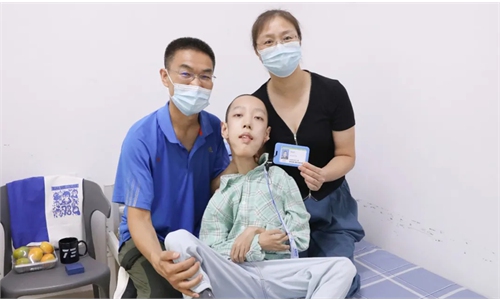Over 5 mln primary and high school Chinese students suffer from spinal deformity, arousing theory about overly heavy schoolbags

Photo: VCG
The topic that over 5 million primary and high school students in China currently suffer from spinal deformities, with the number increasing by about 300,000 every year, trended on China's social media on Thursday, with many netizens attributing the situation to Chinese students' heavy schoolbags.
According to a report by China Central Television (CCTV), scoliosis has become the third major disease endangering the health of Chinese children and adolescents following obesity and myopia.
The statistics were estimated based on research conducted by the committee for prevention and control of spinal diseases under the Chinese Preventive Medicine Association combined with the consensus of authoritative magazines and domestic experts, CCTV reported.
According to the report, a 13-year-old girl from Hengshui, in North China's Hebei Province, was diagnosed with severe scoliosis, which a doctor thought was caused by long-term poor sitting posture. If her condition was not fixed, it could result in uneven shoulders, legs of different lengths, body deformities and other serious consequences.
On China's Twitter-like Sina Weibo, many netizens attributed the situation to students' heavy schoolbags, and inappropriate sizes and heights of desks for children in different physical developmental stages.
A netizen pointed out that although Chinese children's average height is taller today than in the past, the sizes of desks and chairs remain unchanged.
According to Liu Haiying, head of the department of spine surgery at Peking University People's Hospital, scoliosis is a deformity of the spine that caused it to deviate from the normal midline, which is combined with a rotation of the spine.
According to Liu, there are many types of scoliosis, the most common are congenital scoliosis, idiopathic scoliosis and neuromuscular scoliosis, among which idiopathic scoliosis is the most common type that affects children and adolescents. The etiology of the disease still remains unknown.
It appears in childhood or adolescence when children and adolescents grow and develop the fastest. Besides, poor sitting postures, carrying schoolbags improperly, and the height of desks and chairs can also be factors that cause the disease.
Women at the peak of their growth are more likely to suffer from the disease, with an incidence rate up to 1.5 times as often as men.
At present, scoliosis screening has been included in the routine physical examinations of every school year or the routine physical examinations for freshmen. Early detection and diagnosis are the best prevention and treatment strategies for scoliosis, experts noted, reminding that physical exercises, such as hanging on a bar, playing basketball and swimming are also good options to prevent scoliosis.
Global Times


